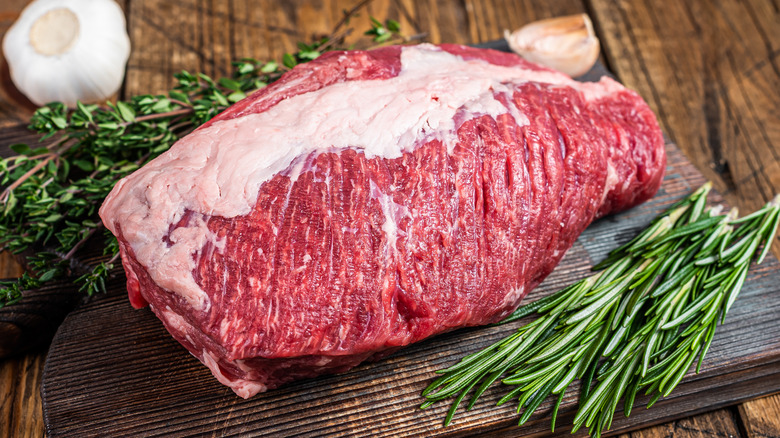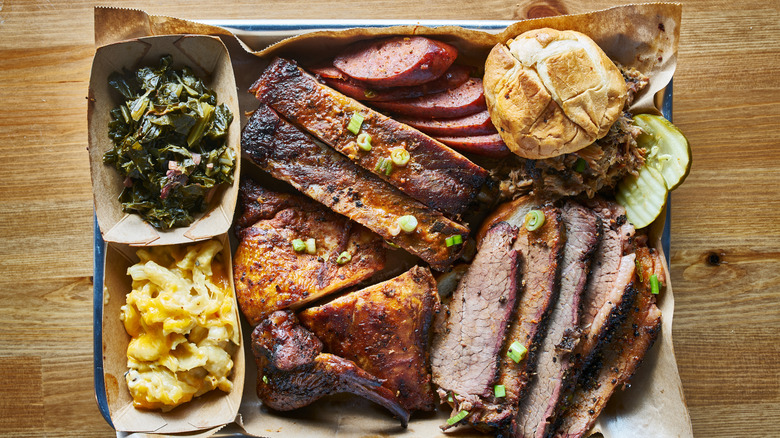The Absolute Best Ways To Reheat Brisket
Some cuts of meat are best for pot roast; others are best for searing. Still, others fall in the middle. Brisket can be a love-it-or-leave-it cut of beef, not because it is unpleasant, but because if it isn't cooked properly, it could turn out to be toughest piece of meat you could either eat or serve.
Brisket is the way it is because of what it is, and where it can be found. Per The Spruce Eats, this particular cut of beef is found in a cow's breast section, beneath its ribs and behind the foreshank. This area also supports the cow's weight, which can partly explain why it is so tough. Then there is the cut itself, which is made of the pectoral muscle, and is also filled with collagen, which needs plenty of time and low heat to cook.
According to BBQ Host, two common mistakes when preparing brisket are expecting it to cook quickly and attempting to get the job done by exposing it to a hot fire. Both of these will leave you with a chewy meal. Instead, as Food Network points out, cooking brisket low and slow in a slow cooker or Instant Pot, a smoker, or in the oven are the best ways to make sure you won't be reaching for the phone to order takeout. You can use baking soda to tenderize meat, but this isn't the place for that.
And just as cooking brisket takes patience, reheating leftovers will need the same amount of perseverance, too, since reheating it quickly will leave you with exactly what you were trying to avoid: a tough piece of jerky.
Reheating brisket in an oven or smoker
Southern Living is of the belief that food should, as much as possible, be warmed through the same way it was cooked, so if your brisket was roasted in an oven, you can prep your leftovers the same way. To do this, take the brisket out of the fridge and lay it out on a baking pan, where you can leave it at room temperature for between 20 minutes to half an hour, so you won't be left with a piece that has cold spots after its time in the oven is done. Moisten the beef with its own juices or beef broth, then cover the cut with two pieces of foil, making sure it is sealed properly before leaving it in an oven preheated to 325 F, per Insanely Good. A whole brisket will need an hour to cook, but a smaller piece will need just about 20 minutes.
If you have your smoker at the ready, Insanely Good says you can prep your brisket by wrapping it with foil and laying it in the coolest part of the cooking area, and leaving it to warm up until the meat's internal temperature hits 155 F. From there, the meat can be moved to a hotter part of the smoker for 5 minutes before serving.
Reheating brisket in a slow cooker or instant pot
If your kitchen is home to a slow cooker, the gadget can help you revive a cold, sleeping piece of brisket from its slumber, too. To reheat your brisket in a slow cooker, Southern Living suggests you remove the brisket from the refrigerator and let it rest for about 20 minutes before slicing up the meat, and putting it into the cooker along with the pan juices and the congealed bits of fat. Set to low and cook for between three to four hours. In the absence of any pan drippings, beef stock or barbecue sauce can be added to keep the meat moist.
Insanely Good says if you have a sous vide, you can use that to reheat brisket, too, just prepared for the process to up to five hours, too. The cut of meat will be ready to eat when its temperature is the same as that of the water bath it is cooked in.
But all these methods may be for naught if the brisket isn't stored properly; to do this, Insanely Good suggests first wrapping the meat with plastic wrap and then putting it in a freezer bag, ensuring it is properly sealed. And under no condition must brisket be reheated in a microwave oven, per Southern Living.


